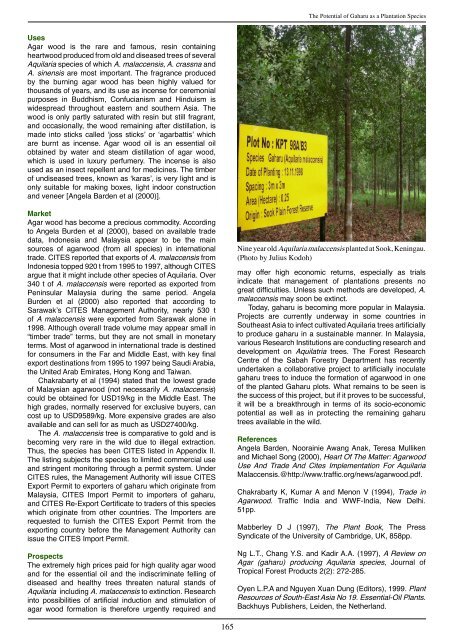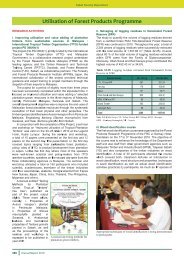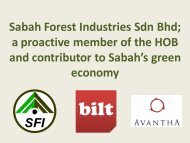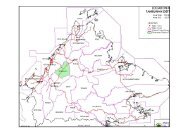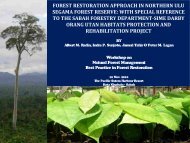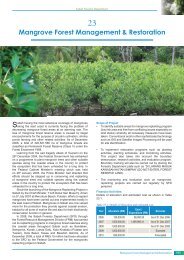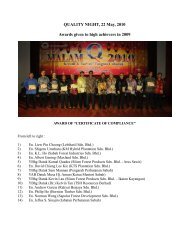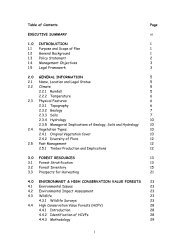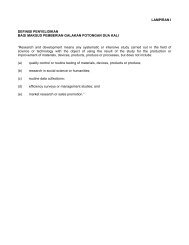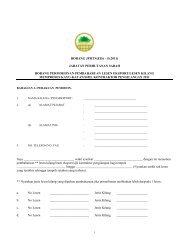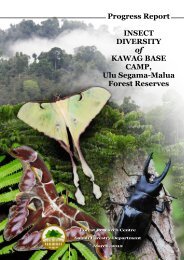22i Gaharu.pdf - Sabah Forestry Department
22i Gaharu.pdf - Sabah Forestry Department
22i Gaharu.pdf - Sabah Forestry Department
- No tags were found...
You also want an ePaper? Increase the reach of your titles
YUMPU automatically turns print PDFs into web optimized ePapers that Google loves.
The Potential of <strong>Gaharu</strong> as a Plantation SpeciesUsesAgar wood is the rare and famous, resin containingheartwood produced from old and diseased trees of severalAquilaria species of which A. malaccensis, A. crassna andA. sinensis are most important. The fragrance producedby the burning agar wood has been highly valued forthousands of years, and its use as incense for ceremonialpurposes in Buddhism, Confucianism and Hinduism iswidespread throughout eastern and southern Asia. Thewood is only partly saturated with resin but still fragrant,and occasionally, the wood remaining after distillation, ismade into sticks called ‘joss sticks’ or ‘agarbattis’ whichare burnt as incense. Agar wood oil is an essential oilobtained by water and steam distillation of agar wood,which is used in luxury perfumery. The incense is alsoused as an insect repellent and for medicines. The timberof undiseased trees, known as ‘karas’, is very light and isonly suitable for making boxes, light indoor constructionand veneer [Angela Barden et al (2000)].MarketAgar wood has become a precious commodity. Accordingto Angela Burden et al (2000), based on available tradedata, Indonesia and Malaysia appear to be the mainsources of agarwood (from all species) in internationaltrade. CITES reported that exports of A. malaccensis fromIndonesia topped 920 t from 1995 to 1997, although CITESargue that it might include other species of Aquilaria. Over340 t of A. malaccensis were reported as exported fromPeninsular Malaysia during the same period. AngelaBurden et al (2000) also reported that according toSarawak’s CITES Management Authority, nearly 530 tof A malaccensis were exported from Sarawak alone in1998. Although overall trade volume may appear small in“timber trade” terms, but they are not small in monetaryterms. Most of agarwood in international trade is destinedfor consumers in the Far and Middle East, with key finalexport destinations from 1995 to 1997 being Saudi Arabia,the United Arab Emirates, Hong Kong and Taiwan.Chakrabarty et al (1994) stated that the lowest gradeof Malaysian agarwood (not necessarily A. malaccensis)could be obtained for USD19/kg in the Middle East. Thehigh grades, normally reserved for exclusive buyers, cancost up to USD9589/kg. More expensive grades are alsoavailable and can sell for as much as USD27400/kg.The A. malaccensis tree is comparative to gold and isbecoming very rare in the wild due to illegal extraction.Thus, the species has been CITES listed in Appendix II.The listing subjects the species to limited commercial useand stringent monitoring through a permit system. UnderCITES rules, the Management Authority will issue CITESExport Permit to exporters of gaharu which originate fromMalaysia, CITES Import Permit to importers of gaharu,and CITES Re-Export Certificate to traders of this specieswhich originate from other countries. The Importers arerequested to furnish the CITES Export Permit from theexporting country before the Management Authority canissue the CITES Import Permit.ProspectsThe extremely high prices paid for high quality agar woodand for the essential oil and the indiscriminate felling ofdiseased and healthy trees threaten natural stands ofAquilaria including A. malaccensis to extinction. Researchinto possibilities of artificial induction and stimulation ofagar wood formation is therefore urgently required andNine year old Aquilaria malaccensis planted at Sook, Keningau.(Photo by Julius Kodoh)may offer high economic returns, especially as trialsindicate that management of plantations presents nogreat difficulties. Unless such methods are developed, A.malaccensis may soon be extinct.Today, gaharu is becoming more popular in Malaysia.Projects are currently underway in some countries inSoutheast Asia to infect cultivated Aquilaria trees artificiallyto produce gaharu in a sustainable manner. In Malaysia,various Research Institutions are conducting research anddevelopment on Aquilatria trees. The Forest ResearchCentre of the <strong>Sabah</strong> <strong>Forestry</strong> <strong>Department</strong> has recentlyundertaken a collaborative project to artificially inoculategaharu trees to induce the formation of agarwood in oneof the planted <strong>Gaharu</strong> plots. What remains to be seen isthe success of this project, but if it proves to be successful,it will be a breakthrough in terms of its socio-economicpotential as well as in protecting the remaining gaharutrees available in the wild.ReferencesAngela Barden, Noorainie Awang Anak, Teresa Mullikenand Michael Song (2000), Heart Of The Matter: AgarwoodUse And Trade And Cites Implementation For AquilariaMalaccensis.@http://www.traffic.org/news/agarwood.<strong>pdf</strong>.Chakrabarty K, Kumar A and Menon V (1994), Trade inAgarwood. Traffic India and WWF-India, New Delhi.51pp.Mabberley D J (1997), The Plant Book, The PressSyndicate of the University of Cambridge, UK, 858pp.Ng L.T., Chang Y.S. and Kadir A.A. (1997), A Review onAgar (gaharu) producing Aquilaria species, Journal ofTropical Forest Products 2(2): 272-285.Oyen L.P.A and Nguyen Xuan Dung (Editors), 1999. PlantResources of South-East Asia No 19. Essential-Oil Plants.Backhuys Publishers, Leiden, the Netherland.165


